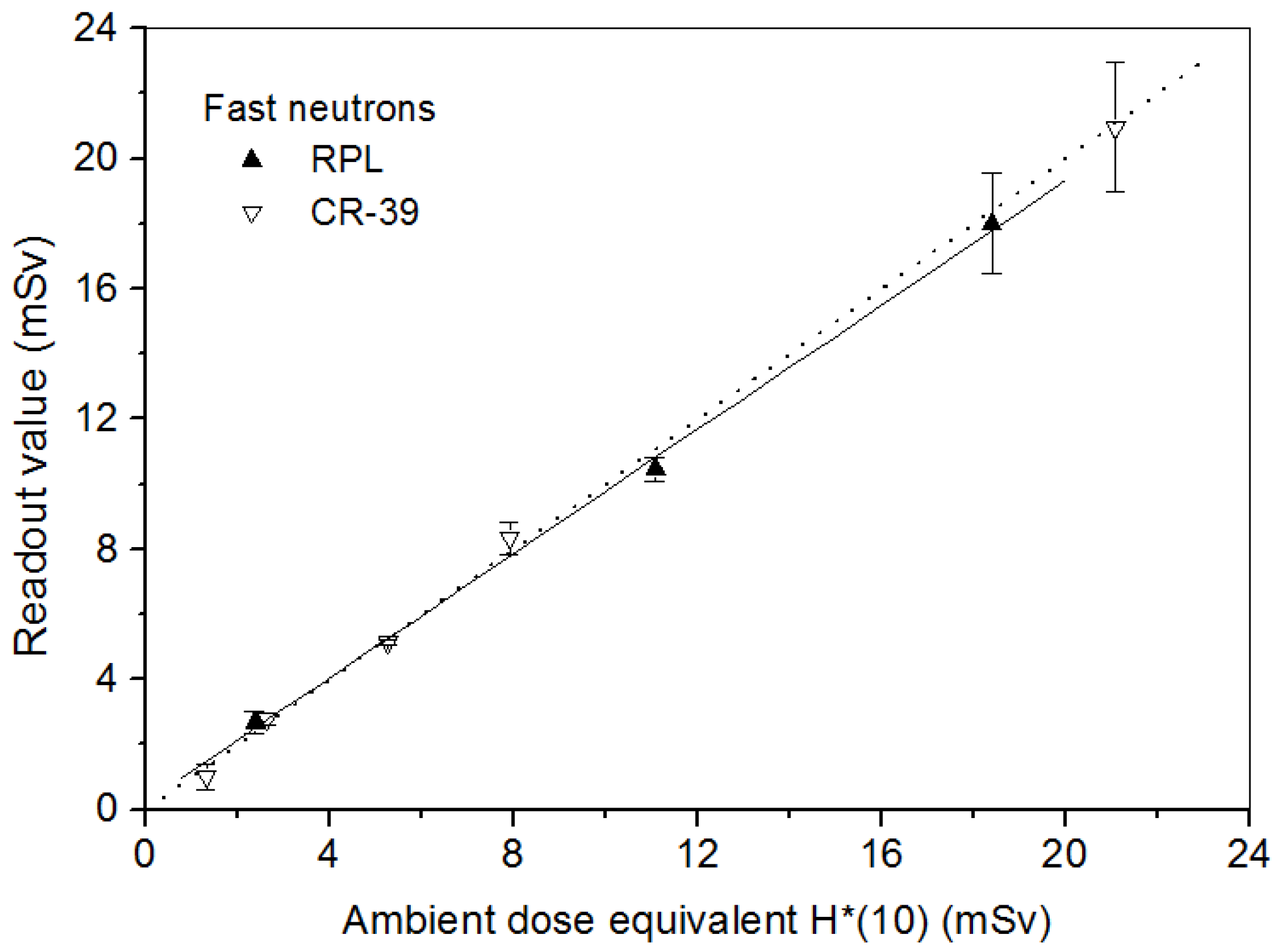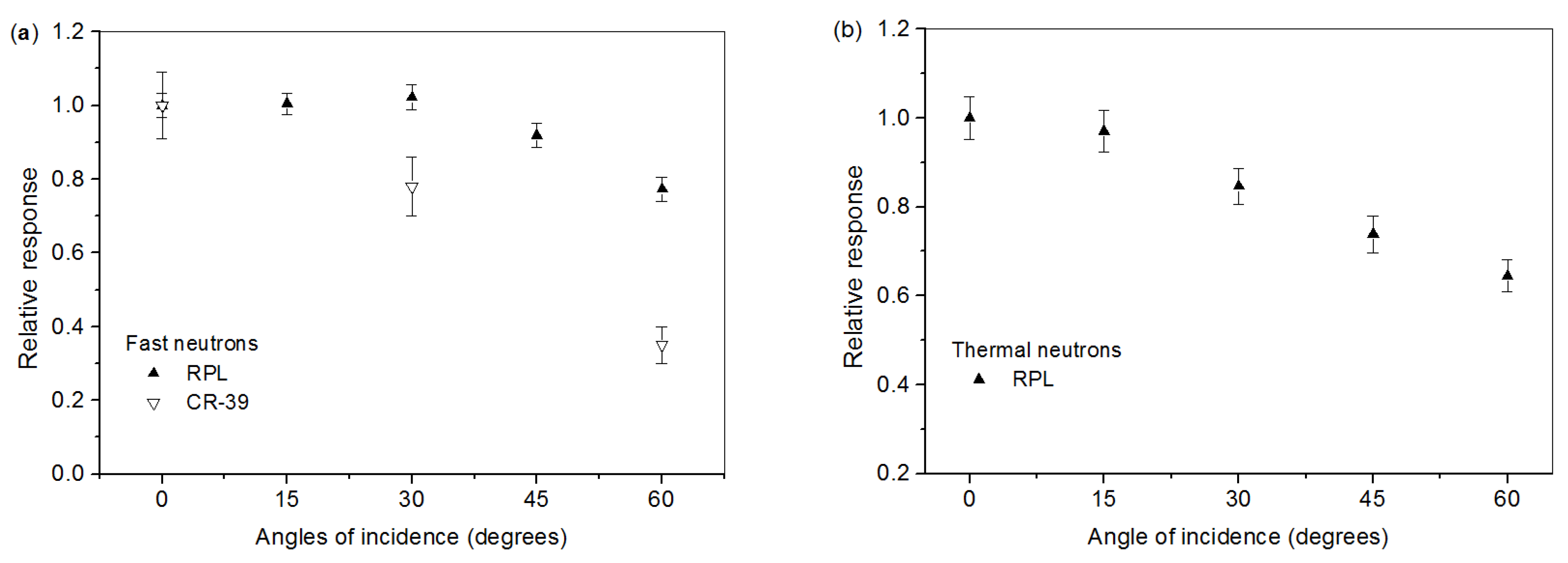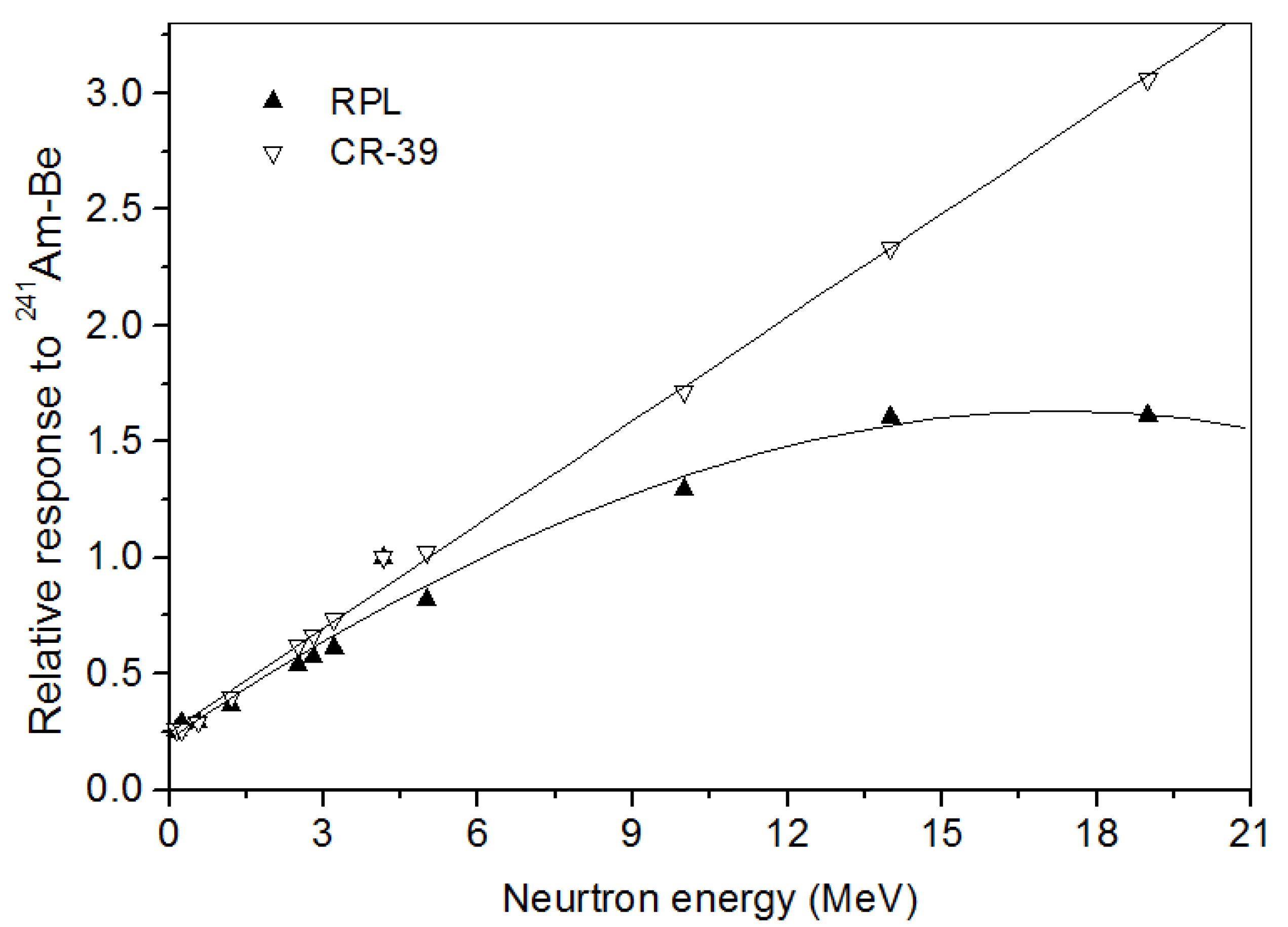RPL Neutron Dosimetry in n-γ Fields in Comparison with Polymer Detectors Type CR-39
Abstract
:1. Introduction
2. Etching Nuclear Tracks
3. Materials and Methods
3.1. RPL Glass Dosimeter
3.2. CR-39 Dosimeter
3.3. RPL Neutron Dosimeter
3.3.1. Fast Neutrons
3.3.2. Thermal Neutrons
3.4. Irradiations
4. Results and Discussion
4.1. Reproducibility
4.2. Dose Response
4.2.1. Dosimeter Response in Terms of Ambient Dose Equivalent H*(10)
4.2.2. Dosimeter Response in Terms of Personal Dose Equivalent Hp(10)
4.3. Angular Dependence
4.4. Energy Dependence
5. Conclusions
Author Contributions
Funding
Institutional Review Board Statement
Informed Consent Statement
Data Availability Statement
Conflicts of Interest
References
- Nénot, J.; Brenot, J.; Laurier, D.; Rannou, A.; Thierry, D. Publication 103 de la CIPR. Recommandations 2007 de la Commission Internationale de Protection Radiologique; TEC & DOC: Lavoisier Paris, France, 2007. [Google Scholar]
- McWhan, A.F.; Dobrzynska, W.; Grimbergen, T.W.M.; Figel, M.; Romero, A.M.; Stadtmann, H. EURADOS intercomparison 2010 for whole body dosemeters in photon fields. EURADOS Rep. 2015, 1, 2015. [Google Scholar]
- Croft, S.; Weaver, D.; Heffer, P.J.H. The application of radiophotoluminescent glass to Gamma dosimetry in mixed n-Gamma fields. Radiat. Protect. Dosim. 1986, 17, 67–70. [Google Scholar] [CrossRef]
- Miljanić, S.; Ranogajec-Komor, M.; Blagus, S.; Pàlfalvi, J.K.; Pàzmàndi, T.; Deme, S.; Szàntó, P. Response of radiophotoluminescent dosimeters to neutrons. Radiat. Meas. 2008, 43, 1068–1071. [Google Scholar] [CrossRef]
- Makovicka, L.; Barelaud, B.; Decossas, J.L.; Vareille, J.C. Detection of thermal neutrons by CR-39 using a boron implanted converter. Radiat. Protect. Dosim. 1988, 23, 191–194. [Google Scholar] [CrossRef]
- Vilela, E.; Fantuzzi, E.; Giuacomelli, G. Optimization of CR-39 for fast neutron dosimetry applications. Radiat. Meas. 1991, 31, 437–442. [Google Scholar] [CrossRef]
- Ahmad, N.; Matiullah and Kenawy, M.A. A CR-39 based thermal neutron dosimeter. Radiat. Meas. 1997, 28, 413–414. [Google Scholar] [CrossRef]
- Belafrites, A.; Nourreddine, A.; Mouhssine, D.; Nachab, A.; Boucenna, A. Response of PN3 dosimeters to 239Pu–Be neutrons. Radiat. Meas. 2005, 39, 241–244. [Google Scholar] [CrossRef]
- Castillo, F.; Espinosa, G.; Golzarri, J.I.; Osorio, D.; Rangel, J.; Reyes, P.G.; Herrera, J.J.E. Fast neutron dosimetry using CR-39 track detectors with polyethylene as radiator. Radiat. Meas. 2013, 50, 71–73. [Google Scholar] [CrossRef]
- Milenkovic, B.; Stevanovic, N.; Nikezic, D.; Kosutic, D. Determination of a CR-39 detector response to neutrons from an Am–Be source. Appl. Radiat. Isot. 2014, 90, 225–228. [Google Scholar] [CrossRef]
- Tommasino, L.; Zapparoli, G.; Spiezia, P.; Griffith, R.V.; Espinosa, G. Different etching processes of damage track detectors for Personnel Neutron Dosimetry. Nucl. Tracks Radiat. Meas. 1984, 8, 335–339. [Google Scholar] [CrossRef]
- Espinosa, G.; Gammage, R.B.; Meyer, K.; Wheeler, R.B.; Salasky, M. Alpha radiation detection and analysis by nuclear track detectors. Radiat. Protect. Dosim. 1995, 59, 227–229. [Google Scholar] [CrossRef]
- Ho, J.P.Y.; Yip, C.W.Y.; Nikezic, D.; Yu, K.N. Effects of stirring on the bulk etch rate of CR-39 detector. Radiat. Meas. 2001, 36, 141–143. [Google Scholar] [CrossRef]
- Belafrites, A.; Nourreddine, A.; Higueret, S.; Lê, T.; Trocmé, M. Dependence of PN3 response to Am–Be neutrons on etching and reading process. Radiat. Meas. 2008, 43, S482–S486. [Google Scholar] [CrossRef]
- Sahoo, G.S.; Tripathy, S.P.; Sharma, S.D.; Bandyopadhyay, T. Effect of etchant concentration on microwave induced chemical etching (MICE) of CR-39 detector. Nucl. Instr. Meth. Phys. Res. A 2015, 800, 51–56. [Google Scholar] [CrossRef]
- Girod, M.; Bourgois, L.; Cornillaux, G.; Andre, S.; Postaük, J. Study and presentation of a fast neutron and photon dosimeter for area and criticality monitoring using radiophotoluminescent glass. Radiat. Protect. Dosim. 2006, 112, 359–370. [Google Scholar] [CrossRef]
- Maki, D.; Sato, F.; Murata, I.; Kato, Y.; Tanimura, Y.; Yamamoto, T.; Iida, T. Development of neutron-sensitive glass dosimeter containing isotopically enriched boron. Radiat. Meas. 2011, 46, 1484–1487. [Google Scholar] [CrossRef]
- Salem, Y.O.; Nachab, A.; Roy, C.; Nourreddine, A. Dosimeter incorporating radiophotoluminescent detectors for thermal neutrons and γ-rays in n-γ fields. Nucl. Instr. Meth. Phys. Res. B 2016, 385, 15–18. [Google Scholar] [CrossRef]
- Fleischer, R.L.; Price, P.B.; Walker, R.M. Nuclear Tracks in Solids; University of California Press: Berkeley, CA, USA, 1975. [Google Scholar]
- Fleisher, R.L.; Price, P.B.; Walker, R.M. Nuclear Tracks in Solids: Principles and Applications; University of California Press: Berkeley, CA, USA, 1975; ISBN 0-520-02665-9. [Google Scholar]
- Tawara, H.; Eda, K.; Sanami, T.; Sasaki, S.; Takahashi, K.; Sonkawade, R.; Nagamatsu, A.; Kitajo, K.; Kumagai, H.; Doke, T. Dosimetry for Neutrons from 0.25 to 15 MeV by the Measurement of Linear Energy Transfer Distributions for Secondary Charged Particles in CR-39 Plastic. Jpn. J. Appl. Phys. 2008, 47, 1726. [Google Scholar] [CrossRef]
- Elazhar, H.; Chami, A.C.; Abdesselam, M.; Arbor, N.; Muller, D.; Nasreddine, A.; Roumie, M.; El Bitar, Z.; Nourreddine, A. Light particle spectroscopy using CR-39 detectors: An experimental and simulation study. Nucl. Instr. Meth. Phys. Res. B 2019, 448, 52–56. [Google Scholar] [CrossRef]
- Hocine, N.; Donadille, L.; Huet, C.; Itié, C.; Clairand, I. Personal monitor glass badge: Theoretical dosemeter response calculated with the monte carlo transport code MCNPX. Radiat. Protect. Dosim. 2011, 144, 231–233. [Google Scholar] [CrossRef]
- Huang, D.Y.C.; Hsu, S.-M. Radio-Photoluminescence Glass Dosimeter (RPLGD); Advances in Cancer Therapy; Gali-Muhtasib, H., Ed.; InTech: Rijeka, Croatia, 2011; ISBN 978-953-307-703-1. Available online: http://www.intechopen.com/books/advances-in-cancer-therapy/radio-photoluminescence-glass-dosimeterrplgd (accessed on 20 January 2022).
- Salem, Y.O.; Nourreddine, A.; Nachab, A.; Roy, C.; Pape, A. Present state of the art of a fast neutron dosimeter incorporating RPL detectors. J. Nucl. Sci. 2015, 2, 53–58. [Google Scholar]
- Jahn, W.; Schumann, W. Glass for Radio Photoluminescence Dosimetry. U.S. Patent No. 4204976, 27 May 1980. [Google Scholar]
- Miyamoto, Y.; Kinoshita, K.; Koyama, S.; Takei, Y.; Nanto, H.; Yamamoto, T.; Sakakura, M.; Shimotsuma, Y.; Miura, K.; Hirao, K. Emission and excitation mechanism of radiophotoluminescence in Ag+-activated phosphate glass. Nucl. Instrum. Meth. Phys. Res. A 2010, 619, 71–74. [Google Scholar] [CrossRef]
- Price, P.B.; Walker, R.M. Chemical etching of charged-particle tracks in solids. J. Appl. Phys. 1962, 33, 3407–3412. [Google Scholar] [CrossRef]
- Mukhtar, A.R.; Qureshi, I.E. Studies of CR-39 etch rates. Nucl. Instr. Meth. Phys. Res. B 2002, 198, 129–134. [Google Scholar]
- Nourreddine, A.; Arbor, N.; Riffaud, J.; Belafrites, A.; Chefson, S.; Courson, O.; Kuntz, F.; Ludwig, N.; Nasreddine, A.; Salem, Y.O.; et al. Development of Electron Beam and X-ray Applications for Food Irradiation (DEXAFI); Final Report of Coordinated Research Project D61025; IAEA TECDOC: Vienna, Austria, 2022. [Google Scholar]
- Nourreddine, A.; Salem, Y.O.; Nachab, A.; Roy, C. Study of a new neutron dosimeter incorporating RPL detectors. Radiat. Meas. 2015, 83, 47–50. [Google Scholar] [CrossRef]
- International Organisation for Standardisation. Neutron Reference Radiations—Part 1: Characteristics and Methods of Production; ISO 8529-1; ISO: Geneva, Switzerland, 2001. [Google Scholar]
- Gressier, V.; Pochat, J.L. The IRSN installations dedicated to the metrology of neutrons. Radioprotection 2006, 41, 11–32. [Google Scholar] [CrossRef]
- Pelowitz, D.B.; Durkee, J.W.; Elson, J.S.; Fensin, M.L.; James, M.R.; Johns, R.C.; McKinney, G.W.; Mashnik, S.G.; Verbeke, J.M.; Waters, L.S. MCNPX Version 2.7.0 Extensions; Los Alamos National Laboratory: Santa Fe, NM, USA, 2011; LA-UR-11-02295. [Google Scholar]
- International Commission on Radiation Units and Measurements. Measurement of Dose Equivalents from External Photon and Electron Radiations; ICRU Report 47; ICRU: Bethesda, MD, USA, 1992. [Google Scholar]
- Hsu, S.-M.; Yeh, S.-H.; Lin, M.-S.; Chen, W.-L. Comparison on characteristics of radiophotoluminescent glass dosemeters and thermoluminescent dosemeters. Radiat. Protect. Dosim. 2006, 119, 327–331. [Google Scholar] [CrossRef]
- Traoré, I.; Nachab, A.; Nourreddine, A.; Bâ, A. Characterization of a PN3 personal neutron dosimeter based on (n,α) reaction. Results Phys. 2015, 5, 144–147. [Google Scholar] [CrossRef] [Green Version]
- Somogyi, G.; Szalay, S.A. Track-diameter kinetics in dielectric track detectors. Nucl. Instr. Meth. 1973, 2, 211–232. [Google Scholar] [CrossRef]
- Kodaira, S.; Morishige, K.; Kawashima, H.; Kitamura, H.; Kurano, M.; Hasebe, N.; Koguchi, Y.; Shinozaki, W.; Ogura, K. A performance test of a new high-surface-quality and high-sensitivity CR-39 plastic nuclear track detector—TechnoTrak. Nucl. Instrum. Meth. B 2016, 383, 129–135. [Google Scholar] [CrossRef]
- Tam, N.C.; Baricza, K.; Lakosi, L. Angular and dose depenpence of CR-39 neutron response for shape-selected tracks. Radiat. Meas. 1999, 31, 419–424. [Google Scholar] [CrossRef]
- Makovicka, L.; Decossas, J.L.; Vareille, J.C. Experimental study of the dosimetric efficiency of a radiator CR-39 fast neutron dosimeter. Radiat. Protect. Dosim. 1987, 20, 63–66. [Google Scholar] [CrossRef]
- International Organisation for Standardisation. Passive Personal Neutron Dosimeters—Performance and Test Requirements; ISO 21909; ISO: Geneva, Switzerland, 2005. [Google Scholar]
- El-Sersy, A.R. Study of absolute fast neutron dosimetry using CR-39 track detectors. Nucl. Instr. Meth. Phys. Res. A 2010, 618, 234–238. [Google Scholar] [CrossRef]







| RPL | CR-39 | |||||
|---|---|---|---|---|---|---|
| Hp(10) (mSv) | 2.2 | 4.4 | 8.8 | 1 | 5 | 10 |
| CV (%) | 9.9 | 8.5 | 10.4 | 2.2 | 2.5 | 1.5 |
Publisher’s Note: MDPI stays neutral with regard to jurisdictional claims in published maps and institutional affiliations. |
© 2022 by the authors. Licensee MDPI, Basel, Switzerland. This article is an open access article distributed under the terms and conditions of the Creative Commons Attribution (CC BY) license (https://creativecommons.org/licenses/by/4.0/).
Share and Cite
Salem, Y.O.; Elazhar, H.; Traore, I.; Riffaud, J.; Nourreddine, A. RPL Neutron Dosimetry in n-γ Fields in Comparison with Polymer Detectors Type CR-39. Polymers 2022, 14, 1801. https://doi.org/10.3390/polym14091801
Salem YO, Elazhar H, Traore I, Riffaud J, Nourreddine A. RPL Neutron Dosimetry in n-γ Fields in Comparison with Polymer Detectors Type CR-39. Polymers. 2022; 14(9):1801. https://doi.org/10.3390/polym14091801
Chicago/Turabian StyleSalem, Youbba Ould, Halima Elazhar, Issiaka Traore, Jonathan Riffaud, and Abdelmjid Nourreddine. 2022. "RPL Neutron Dosimetry in n-γ Fields in Comparison with Polymer Detectors Type CR-39" Polymers 14, no. 9: 1801. https://doi.org/10.3390/polym14091801






